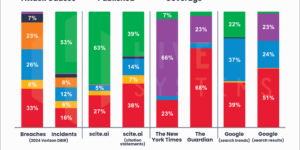The resilience of America’s critical infrastructure networks has been tested over the last year by an increasing number of serious disasters—both natural and manmade—including winter storms shutting down electrical grids in Texas and the ransomware attacks on the Colonial Pipeline and meat producer JBS USA.
An analysis published by Unal Tatar of the College of Emergency Preparedness, Homeland Security and Cybersecurity (CEHC) at the University at Albany and his colleagues is sharing new insight on the potential economic consequences of these infrastructure failures.
The group developed a new analytical model that simulates economic losses caused by disruptions of varying lengths and severity on the 10 most impacted critical infrastructure sectors: state and local general government; miscellaneous professional, scientific, and technical services; administrative and support services; federal government (nondefense); management of companies and enterprises; wholesale trade; computer systems design and related services; other real estate; insurance carriers and related activities; construction.
Their study, published in Risk Analysis, uses the model on a highway transportation network in Virginia. It indicates that economic losses experienced in just a single day from disruptions could range from approximately $8 million to $250 million, depending on the length and severity of the incident.
“The functionality of critical infrastructures, such as transportation, energy, and supply chains, is vital for health, safety, security and economic activity,” said Tatar, an assistant professor at CEHC. “While risk-informed physical network models and economic models have been well-studied, there is limited study of how physical features of network performance interact with sector-specific economic performance, particularly as these networks recover from disruptions of varying durations.”
Highway Infrastructure Disruptions
The Virginia highway scenario relied on publicly available daily traffic data in the Hampton Roads region. It includes 16 cities and counties, such as Virginia Beach, Norfolk and Newport News. The region’s metropolitan area accounted for more than $100 billion in GDP as of 2018, according to the study.
To test their approach, the researchers considered three different scenarios:
- Mild, relatively frequent, conditions (a three-hour disruption)
- Moderately severe conditions (a six-hour disruption)
- Severe, infrequent conditions, such as evacuation during and after a hurricane (one- or two-day disruption)
- Each scenario created a different level of inoperability for “nodes” in the highway’s transportation network (including bridges, tunnels, specific sections of the highway). That inoperability ranged from about 15 percent for a mild disruption to 85 percent after a hurricane evacuation.
The severe scenario resulted in economic losses as high as $256.42 million in a single day, while the mild scenario resulted in $8.07 million in losses and the moderate scenario resulted in $12.49 million in losses.
“Disruptions on single or few nodes can have a drastic impact on network functionality,” Tatar said. “The type of modeling presented in this paper can help critical infrastructure managers who seek to prioritize investments in network reinforcements activity. Moreover, calculating the economic impact of disruptive scenarios will improve risk communication for the public.”
Tatar’s co-authors included Joost Santos of George Washington University and Shital Thekdi of the University of Richmond.
Their findings were presented at the Risk Analysis Virtual Annual Meeting.
The study: Managing Physical and Economic Risk for Systems with Multidirectional Network Interdependencies
Source: State University of New York, University at Albany




















 AI Scams, Emerging New Threats Among McAfee’s 2025 Cybersecurity Predictions
AI Scams, Emerging New Threats Among McAfee’s 2025 Cybersecurity Predictions  Reporter’s Notebook: ‘Nobody Else Does Telematics,’ Lemonade Exec Says
Reporter’s Notebook: ‘Nobody Else Does Telematics,’ Lemonade Exec Says  Carrier Management’s 2024 Top Features (Reader’s Picks Unlocked)
Carrier Management’s 2024 Top Features (Reader’s Picks Unlocked)  Moderating Premium Rates, Falling Yields: European Insurers Resilient
Moderating Premium Rates, Falling Yields: European Insurers Resilient 




